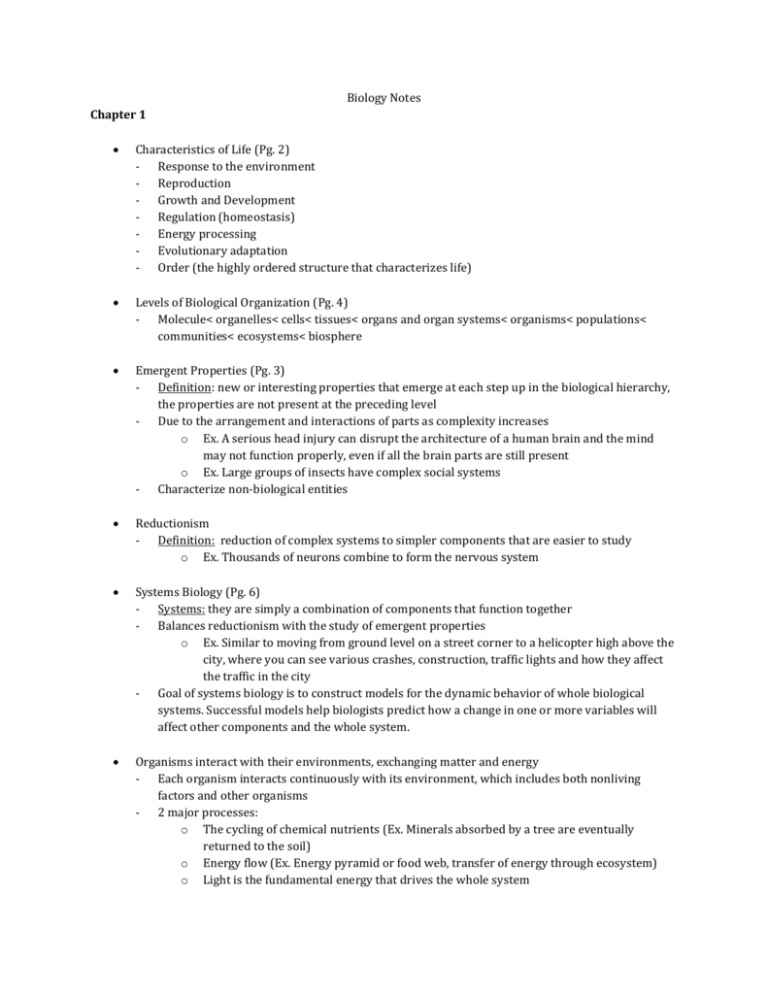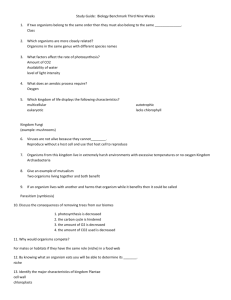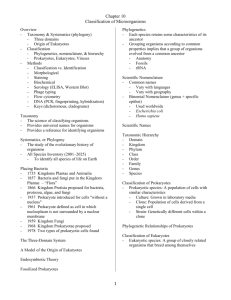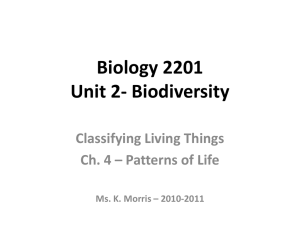Biology Notes Chapter 1 Characteristics of Life (Pg. 2) Response to
advertisement

Biology Notes Chapter 1 Characteristics of Life (Pg. 2) - Response to the environment - Reproduction - Growth and Development - Regulation (homeostasis) - Energy processing - Evolutionary adaptation - Order (the highly ordered structure that characterizes life) Levels of Biological Organization (Pg. 4) - Molecule< organelles< cells< tissues< organs and organ systems< organisms< populations< communities< ecosystems< biosphere Emergent Properties (Pg. 3) - Definition: new or interesting properties that emerge at each step up in the biological hierarchy, the properties are not present at the preceding level - Due to the arrangement and interactions of parts as complexity increases o Ex. A serious head injury can disrupt the architecture of a human brain and the mind may not function properly, even if all the brain parts are still present o Ex. Large groups of insects have complex social systems - Characterize non-biological entities Reductionism - Definition: reduction of complex systems to simpler components that are easier to study o Ex. Thousands of neurons combine to form the nervous system Systems Biology (Pg. 6) - Systems: they are simply a combination of components that function together - Balances reductionism with the study of emergent properties o Ex. Similar to moving from ground level on a street corner to a helicopter high above the city, where you can see various crashes, construction, traffic lights and how they affect the traffic in the city - Goal of systems biology is to construct models for the dynamic behavior of whole biological systems. Successful models help biologists predict how a change in one or more variables will affect other components and the whole system. Organisms interact with their environments, exchanging matter and energy - Each organism interacts continuously with its environment, which includes both nonliving factors and other organisms - 2 major processes: o The cycling of chemical nutrients (Ex. Minerals absorbed by a tree are eventually returned to the soil) o Energy flow (Ex. Energy pyramid or food web, transfer of energy through ecosystem) o Light is the fundamental energy that drives the whole system Energy conversion - Work requires energy - Energy is stored in light, thermal, chemical, kinetic, or thermal forms - Energy exchange between organisms and the environment involves energy transformations - Chemical nutrients recycle within an ecosystem; Energy flows through an ecosystem, usually entering as sunlight and exiting as heat Cells are an organism’s basic unit of structure and function (Pg. 7-8) - A cell is the lowest unit of organization that is a living organism - All cells are enclosed by a phospholipid membrane and use DNA as genetic info - 2 main forms of cells: o Eukaryotic Cell: subdivided into various membrane-enclosed organelles, the nucleus contains DNA, organelles are located in the cytoplasm o Prokaryotic Cell: No nucleus and DNA is not separated from the rest of the cell, no organelles Continuity of life is based on heritable info called DNA (Pg. 8-11) - Chromosomes contain almost all of the cell’s DNA - DNA is made up of genes: the units of inheritance that transmit info from parents to offspring - Genome: the entire collection of genetic instructions that an organism inherits - Bioinformatics: the use of computational tools to store, organize, and analyze the huge volume of data that result from high-throughput methods Feedback mechanisms regulate biological systems - In feedback regulation, the product (output) of a process self-regulates - Negative Feedback: more product accumulating process slowing down and less product being produced - Positive Feedback: (favorable but less common) more product accumulating process speeding up and more product being produced o Ex. In labor, a chemical is released more and more contractions get closer and closer Evolution accounts for the unity and diversity of life (Pg. 12) - Taxonomy: the branch of bio that names and classifies animals - Naming is like, Genus species, or it’s underlined when writing; the species is never capitalized, Latin names are used o Ex. Ursus americanus (American black bear) - Organizing the diversity of life: o Domain> Kingdom> Phylum> Class> Order> Family> Genus> Species - 3 domains of life: o Domain Bacteria: most diverse and widespread prokaryotes o Domain Archaea: prokaryotes that live in extreme environments (also called extremophiles; expected to be found on Mars) o Domain Eukarya: Includes 3 multicellular Kingdoms: Kingdom Plantae: produce their own sugars and food by photosynthesis - Kingdom Fungi: absorb dissolved nutrients from their surroundings, many decompose dead organisms and wastes Kingdom Animalia: obtain food by ingestion of other organisms Kingdom Protista: single-celled eukaryotes (also includes some multicellular forms, seaweed, that are closely related to unicellular protists) Striking unity underlies the diversity of life, evident in many features of cell structure o Ex. Cilia of Paramecium is similar to cilia of Windpipe cells Evolution and Natural Selection (Pg. 14-18) - Fossils and other evidence document evolution of life - Charles Darwin published On the Origin of Species by Means of Natural Selection o 2 main points: Presented evidence to support his view that contemporary species arose from a succession of ancestors; called this evolutionary history of species “descent with modification” Proposed a mechanism for descent with modification; it’s called theory of natural selection Darwin observed that individuals in populations have varied traits, traits are heritable, more offspring is produced than what can survivecompetition is inevitable, and species suit their environments Reasoned that individuals best suited to their environments are more likely to survive and reproduce o Darwin proposed natural selection could cause ancestral species to give rise to 2 or more descendant species Ex. Finches in Galapagos Islands o Natural selection is evident in adaptations of organisms to environment Ex. Bat wings - Evolution occurs as the unequal reproductive success of individuals adapts the population to its environment Scientists use inquiries (Pg. 18) - Definition: a search for info and explanation, often focusing on specific questions - 2 main types: o Hypothesis-based Science: about explaining nature and what causes something to happen, involves proposing and testing hypotheses o Discovery Science: describes natural structures and processes through careful observation and analysis of data - Data o Quantitative: recorded measurements o Qualitative: descriptions - Inductive reasoning: derivation of generalizations from a large number of specific observations; specific general o Ex. The sun always rises in the east - Deductive reasoning: extrapolating the specific results we should expect from general premises that are true; general specific o Ex. If all organisms are made of cells, and humans are organisms, then humans are composed of cells Hypothesis (Pg. 19) - Definition: a tentative answer to a well-framed questions, an explanation on trial - Leads to predictions that can either be tested for validity or falsified - Observations and results must be repeatable - Science can’t support or falsify supernatural explanations (it’s outside of bounds, can’t be tested) Theory (Pg. 23) - Definition: a theory is broader than a hypothesis, general and can lead to a new hypothesis, and is supported by a large body of evidence - Models are used to represent natural phenomena and are predictive tools Controlled Experiment (Pg. 22) - Definition: one that is used to compare an experiment group with a control group - Experimental group and control group ideally only vary in the factor that is being tested - Researchers “control” unwanted variables not by eliminating them through environmental regulation, but by canceling their effects by using control groups Technology (Pg. 24) - Definition: technology applies scientific knowledge for some specific purpose - The goal of science is to understand natural phenomena; biologists often speak of “discoveries” while engineers speak of “inventions”











